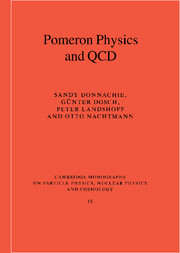Book contents
- Frontmatter
- Contents
- Preface
- 1 Properties of the S-matrix
- 2 Regge poles
- 3 Introduction to soft hadronic processes
- 4 Duality
- 5 Photon-induced processes
- 6 QCD: perturbative and nonperturbative
- 7 Hard processes
- 8 Soft diffraction and vacuum structure
- 9 The dipole approach
- 10 Questions for the future
- Appendix A Sommerfeld-Watson transform
- Appendix B The group SU(3)
- Appendix C Feynman rules of QCD
- Appendix D Pion-nucleon amplitudes
- Appendix E The density matrix of vector mesons
- References
- Index
8 - Soft diffraction and vacuum structure
Published online by Cambridge University Press: 19 August 2009
- Frontmatter
- Contents
- Preface
- 1 Properties of the S-matrix
- 2 Regge poles
- 3 Introduction to soft hadronic processes
- 4 Duality
- 5 Photon-induced processes
- 6 QCD: perturbative and nonperturbative
- 7 Hard processes
- 8 Soft diffraction and vacuum structure
- 9 The dipole approach
- 10 Questions for the future
- Appendix A Sommerfeld-Watson transform
- Appendix B The group SU(3)
- Appendix C Feynman rules of QCD
- Appendix D Pion-nucleon amplitudes
- Appendix E The density matrix of vector mesons
- References
- Index
Summary
In this chapter we discuss an approach whereby soft diffractive phenomena are treated from a microscopic point of view starting from the scattering of the hadrons constituents, that is quarks and gluons, and we relate scattering phenomena to properties of the QCD vacuum. We have argued in chapter 6 that in QCD total cross sections are essentially nonperturbative quantities. Thus it is quite natural to think about a possible connection between the nontrivial vacuum structure of QCD, which is a typical nonperturbative phenomenon, and soft high-energy reactions.
The Landshoff-Nachtmann model
The Landshoff-Nachtmann model[7] seeks to understand some features of diffractive phenomena in hadron-hadron scattering in terms of the exchange of two nonperturbative gluons between quarks. It was shown that this model is capable of reproducing the additive-quark rule for total cross sections[89,415417], which we introduced in chapter 3. If one calculates two-gluon exchange in QCD perturbation theory, one does not obtain such a result[418,298]. By making detailed assumptions about the nature of the wave functions of mesons and baryons, it is possible to obtain the additive-quark rule for total cross sections from perturbative two-gluon exchange [419,420]. However, this perturbative exchange of two gluons gives the elastic hadron-hadron scattering amplitudes a singularity at t = 0 and does not reproduce the t dependence found in experiment. The observed t dependence is rather related to the elastic form factor and is obtained naturally when one makes the pomeron couple to single quarks like an even-signature isoscalar photon.
- Type
- Chapter
- Information
- Pomeron Physics and QCD , pp. 219 - 268Publisher: Cambridge University PressPrint publication year: 2002

